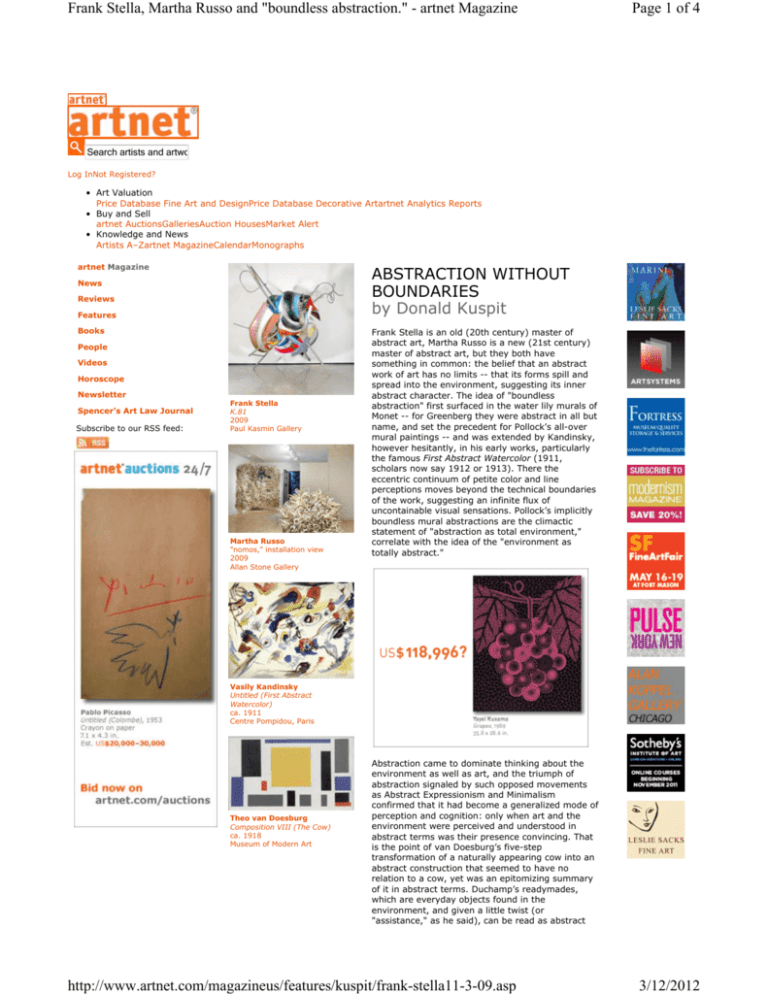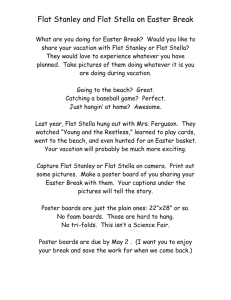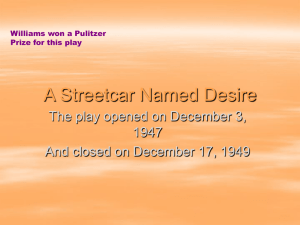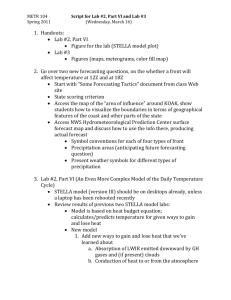
Frank Stella, Martha Russo and "boundless abstraction." - artnet Magazine
Page 1 of 4
Search artists and artwo
Log InNot Registered?
• Art Valuation
Price Database Fine Art and DesignPrice Database Decorative Artartnet Analytics Reports
• Buy and Sell
artnet AuctionsGalleriesAuction HousesMarket Alert
• Knowledge and News
Artists A–Zartnet MagazineCalendarMonographs
artnet Magazine
ABSTRACTION WITHOUT
BOUNDARIES
by Donald Kuspit
News
Reviews
Features
Books
People
Videos
Horoscope
Newsletter
Spencer’s Art Law Journal
Subscribe to our RSS feed:
Frank Stella
K.81
2009
Paul Kasmin Gallery
Martha Russo
"nomos," installation view
2009
Allan Stone Gallery
Frank Stella is an old (20th century) master of
abstract art, Martha Russo is a new (21st century)
master of abstract art, but they both have
something in common: the belief that an abstract
work of art has no limits -- that its forms spill and
spread into the environment, suggesting its inner
abstract character. The idea of "boundless
abstraction" first surfaced in the water lily murals of
Monet -- for Greenberg they were abstract in all but
name, and set the precedent for Pollock’s all-over
mural paintings -- and was extended by Kandinsky,
however hesitantly, in his early works, particularly
the famous First Abstract Watercolor (1911,
scholars now say 1912 or 1913). There the
eccentric continuum of petite color and line
perceptions moves beyond the technical boundaries
of the work, suggesting an infinite flux of
uncontainable visual sensations. Pollock’s implicitly
boundless mural abstractions are the climactic
statement of "abstraction as total environment,"
correlate with the idea of the "environment as
totally abstract."
Vasily Kandinsky
Untitled (First Abstract
Watercolor)
ca. 1911
Centre Pompidou, Paris
Theo van Doesburg
Composition VIII (The Cow)
ca. 1918
Museum of Modern Art
Abstraction came to dominate thinking about the
environment as well as art, and the triumph of
abstraction signaled by such opposed movements
as Abstract Expressionism and Minimalism
confirmed that it had become a generalized mode of
perception and cognition: only when art and the
environment were perceived and understood in
abstract terms was their presence convincing. That
is the point of van Doesburg’s five-step
transformation of a naturally appearing cow into an
abstract construction that seemed to have no
relation to a cow, yet was an epitomizing summary
of it in abstract terms. Duchamp’s readymades,
which are everyday objects found in the
environment, and given a little twist (or
"assistance," as he said), can be read as abstract
http://www.artnet.com/magazineus/features/kuspit/frank-stella11-3-09.asp
3/12/2012
Frank Stella, Martha Russo and "boundless abstraction." - artnet Magazine
Page 2 of 4
artifacts), however manqué. With the triumph of
abstract visual thinking, every dumb thing reads as
abstract art: thus the "surprise" of art, suddenly self
-evident and extraordinarily present in the banally
evident and ordinarily present.
Sol LeWitt’s Brick Wall (1977),
published by Tanglewood Press
Frank Stella
K.43 (lattice variation)
2008
Paul Kasmin Gallery
Frank Stella
K.51
2008
Paul Kasmin Gallery
Frank Stella
K.97
2008
Paul Kasmin Gallery
Martha Russo
nomos (fold)
2009
Allan Stone Gallery
It became de rigueur to see and understand things
abstractly -- it was the modern take on them. To
distill and convert old appearances into new
abstractions was to modernize them. Sol LeWitt’s
photographs of urban geometry -- manholes and
brick walls -- makes the innate and intimate
abstractness of the urban environment explicit,
while suggesting the interchangeability and
simultaneity of abstraction and the representation
of reality. Mondrian came to prefer urban
architecture to natural landscape because the
former was overtly abstract while the latter was
only subliminally abstract -- he spent the first part
of his career extracting that abstractness, no doubt
to convince himself that the abstract was "real." He
came to regard his art as a "representation" of the
"abstract real," in the (mystical?) belief that only
the abstract was (really) real. Abstract art became
the only "correct" and "real" art because it revealed
the abstract truth, which made it seem "scientific" - certainly Mondrian had what could be called a
"scientific esthetics," as his preoccupation with
precision suggests -- or at least an "experimental
esthetics," for his oeuvre is a series of changing
esthetic experiments designed to demonstrate the
reality of the abstract.
Viewed as a whole, Stella’s oeuvre can also be
regarded as a series of esthetic experiments
designed to demonstrate its reality, and
inescapability. Increasingly, his works have
challenged the environment -- come off the wall
and into the environment. In certain installations -I am thinking of one a few years back in the Locks
Gallery in Philadelphia -- his abstractions have
overwhelmed it, and become the environment. We
walk through his abstract wonderland the way
Kandinsky imagined one could walk through an
abstract painting, likening it to the gloriously
colorful Russian Orthodox churches he had walked
through in his youth. Stella’s new sculptures in the
Paul Kasmin gallery are not as overwhelming and all
-encompassing, but they spring into the
environment -- the surrounding space -- like
whirling dervishes, challenging the space to the
extent of dominating it, asserting their physical
presence and complexity with an expressive power
that makes the simple empty space seem beside
their esthetic point.
They in fact have an intricate space of their own,
bound by swiftly moving lines that dramatically flex
their muscles in broad curves and unexpected
angles, and that however binding seem to be
expanding, suggesting the eccentrically curved
universe of the space-time continuum. As virtually
every work shows -- whether in the K17, K43, K51,
K54, K81 and K97 series shows (all 2008 and all
"lattice" variations in different metals) -- the
luminous line surrounds a colorful core of curved
planes, suggesting an atom splitting into
uncontainable fragments. To call Stella’s sculptures
constructions is to miss the point: they are
deconstructions of sculpture into paradoxically
painterly fragments. They are sort of twodimensional expressionistic paintings that expand
into three-dimensional sculptures -- expressionistic
constructions, if one wants, or constructions that
have become expressionistic, thus reconciling the
old Constructivist idea of the artist as engineer and
the old Expressionist idea of the artist as driven by
inner necessity. They thus acquire the "convulsive
beauty" that Breton demanded from Surrealism,
and that for him was the essence of modern and
with that abstract -- he admired the convulsiveness
of Kandinsky’s early breakthrough abstractions --
http://www.artnet.com/magazineus/features/kuspit/frank-stella11-3-09.asp
3/12/2012
Frank Stella, Martha Russo and "boundless abstraction." - artnet Magazine
Page 3 of 4
beauty. It is an amazing epitomizing feat that takes
abstraction to a new level of intimate immediacy
and unconscious power. Stella has fused
expressionist intensity, constructivist calculation,
and surrealist absurdity in works that read as the
grand climax of modernism.
Martha Russo
nomos (fold) (detail)
2009
Allan Stone Gallery
Martha Russo
nomos (cube)
2004
Allan Stone Gallery
Martha Russo
nomos (cube) (detail)
2004
Allan Stone Gallery
But most crucially, at least from the point of view I
am trying to develop here, the new sculptures seem
to unravel: their boundaries break down,
suggesting they are ready to spill their abstract guts
into the environment. The works come undone even
as they are done: lines dangle loosely in space,
spinning centrifugally out of control, exposing the
conflicted core of the work, which seems about to
explode. Lines twist and turn in space, as though
testing the limits of the work, and denying that it
has any. Sometimes the lines are colorful squiggles
-- radiantly blue or green or red -- that seem to
play freely in space, as though independent of the
core, however much they sometimes intersect with
it. Diagonals sometimes thrust through the core like
spears, implicitly extending infinitely into the space
beyond it, while serving as an intrusive axis, thus
intensifying the rolling planes that dramatize the
core. It is as though the core ego holds its own -maintains a precarious integrity -- despite the
onslaught of its own explosive impulses. Mondrian
said that "intensification" is one of the goals of art,
and Stella has given abstract art an intensity it
never achieved before.
Stella’s masterpieces are cognitively as well as
emotionally demanding, all the more so because
they have a swiftness that makes them seem
ungraspable as a whole -- they stretch the limits of
"dynamic equilibrium" to the breaking point.
Russo’s three "nomos" installations, as she calls
them (one on the wall, one on the floor, one in a
high corner of the Allan Stone gallery space),
"grow" and move much more slowly. Made of
porcelain and mixed media, they in fact look like
hollow reeds or the tendrils of an undersea creature
-- animal or plant? -- groping for prey: the
spectator. Their "feelers" reach into space,
compressing it in their proliferation. They have no
boundaries, however nominally contained. One can
imagine them spread across the whole floor and
wall and ceiling -- filling the space, trapping the
viewer in their entanglement.
Some have bits of color, but all are bleached white,
perhaps like dead coral -- Russo’s sculptures have
ecological implications, even as they threaten to
overwhelm the environment in a way not dissimilar
to Stella’s sculptures. Russo offers us a new species
of organic abstraction, while Stella shows us that
constructivist abstraction can be organic while
remaining an engineering feat. Is it safe to say that
Russo represents the "naturalistic" future of
abstract sculpture, while Stella ingeniously
summarizes its "formalist" past, however
calculatedly informal his sculptural look? Both
clearly give abstraction the unfamiliar new look it
badly needed, rescuing it from familiarity and
decadence, showing that its esthetic and expressive
possibilities remain limitless, however difficult to
imagine and realize. It is still an environment that
can facilitate creativity, if one has the creative
brilliance of Stella and Russo.
"Frank Stella: Polychrome Relief," Oct. 1-Nov. 7,
2009, at Paul Kasmin Gallery, 293 Tenth Avenue,
New York, N.Y. 10001.
"Martha Russo: nomos," Sept. 17-Oct. 17, 2009, at
Allan Stone Gallery, 113 East 90th Street, New
York, N.Y. 10128.
http://www.artnet.com/magazineus/features/kuspit/frank-stella11-3-09.asp
3/12/2012
Frank Stella, Martha Russo and "boundless abstraction." - artnet Magazine
Page 4 of 4
DONALD KUSPIT is distinguished professor of art
history and philosophy at SUNY Stony Brook and
A.D. White professor at large at Cornell University.
Share |
0
Print Article
• Art Valuation
◦ Price Database Fine Art and Design
◦ Price Database Decorative Art
◦ artnet Analytics Reports
◦ Market Reports
• Artists
◦ Top 300 Artists
◦ Artist Monographs
◦ Yayoi Kusama
◦ Glenn Ligon
◦ Diego Rivera
• Buy and Sell
◦ artnet Auctions
◦ Galleries
◦ Auction Houses
◦ Market Alert
• artnet Auctions
◦ Prints and Multiples
◦ Modern and Contemporary Art
◦ Photography
◦ Design
◦ Record Prices on artnet Auctions
• Help
◦ About Us
◦ Contact Us
◦ FAQ
◦ Sitemap
◦ artnet.de
◦ artnet.fr
• Knowledge and News
◦ Artists A–Z
◦ artnet Magazine
◦ Calendar
◦ Monographs
◦ Newsletter
• Galleries and Auction Houses
◦ Fine Art Galleries
◦ Contemporary Art in Galleries
◦ Top 10 Prices at Auction
◦ Upcoming Auctions
◦ Recent Auction Results
• Corporate
◦ Products and Services
◦ Terms and Conditions
◦ Privacy Policy
◦ Investor Relations
◦ artnet in the News
◦ Advertise
◦ Careers
• artnet Magazine
◦ Art News
◦ Art Reviews
◦ Art Features
◦ Art People
◦ Horoscope
• Media Relations
◦ Press Inquiries
artnet-The Art World Online. ©2012 Artnet Worldwide Corporation. All rights reserved. artnet® is a registered trademark of Artnet Worldwide Corporation,
New York, NY, USA.
http://www.artnet.com/magazineus/features/kuspit/frank-stella11-3-09.asp
3/12/2012






